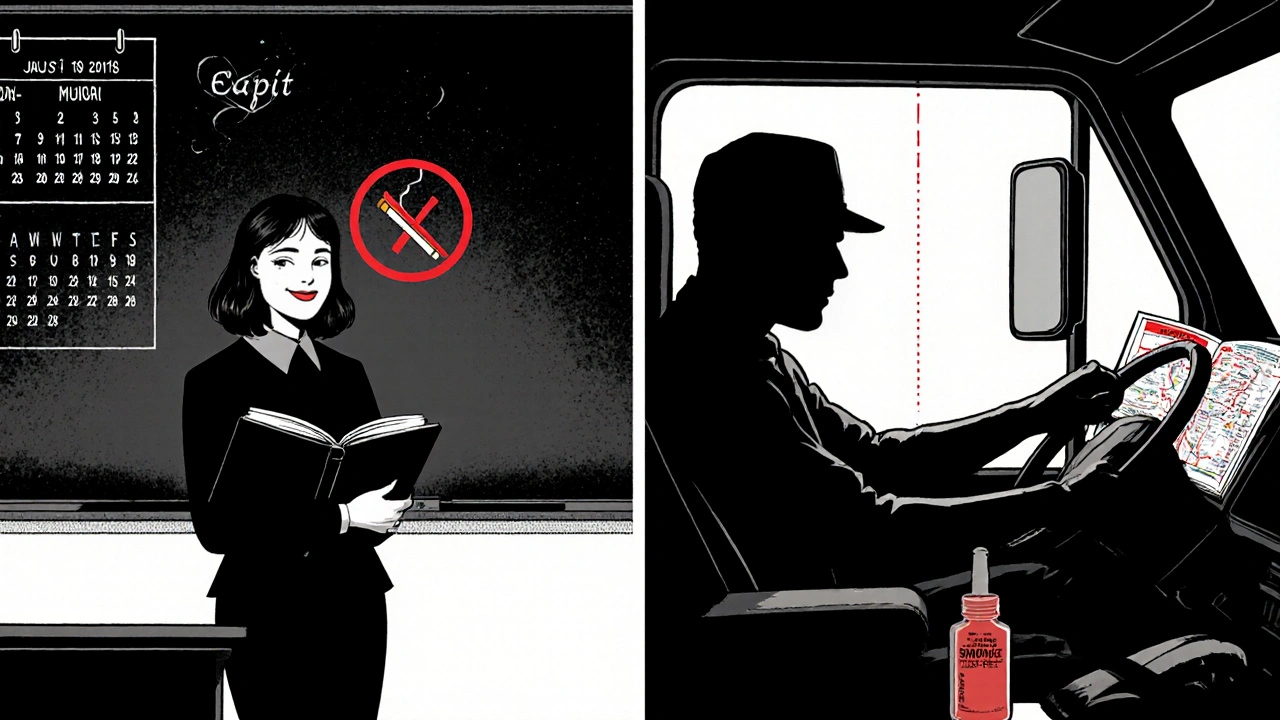15 Oct 2025
- 12 Comments
Quit Success Calculator
Estimate your odds of quitting smoking successfully by combining medication with support groups. Based on clinical data from the New England Journal of Medicine and Cochrane Library.
How This Works
Our calculator uses real clinical data to show how your success rate changes when you combine medication with support groups. Select your approach below to see personalized estimates.
Select your options and click "Calculate Success Rate" to see your estimated odds of quitting successfully.
Trying to quit smoking feels like climbing a mountain while the wind keeps changing direction. Varenicline can give you a strong foothold, but pairing it with a supportive group of fellow quitters can turn that steep climb into a manageable hike. This guide walks you through why the medication and a support group click, how to set them up together, and what to watch out for along the way.
Quick Takeaways
- Varenicline reduces cravings by blocking nicotine receptors and easing withdrawal symptoms.
- Support groups add accountability, shared coping strategies, and emotional backing.
- Start the medication 1 week before your quit date, then join a group that meets weekly or online.
- Track side‑effects early; most are mild and fade within two weeks.
- Compared with nicotine replacement therapy, varenicline doubles the odds of staying smoke‑free at 12weeks.
Below, each step is broken down so you can create a personalized quit plan that actually works.
How Varenicline works
Varenicline (brand name Chantix) is a prescription pill that targets the brain’s nicotinic acetylcholine receptors. Think of these receptors as tiny locks that nicotine fits into to release the “feel‑good” dopamine rush.
When you take varenicline, it does two things:
- Partial agonist: It slips into the lock and triggers a low‑level dopamine release, so you feel a mild sense of satisfaction without smoking.
- Antagonist: It blocks nicotine from binding, meaning if you slip a cigarette, you won’t get the usual high.
Clinical trials published in the New England Journal of Medicine (2010) showed a 44% quit rate at 12weeks for varenicline users versus 30% for placebo. Those numbers jump to about 55% when the drug is combined with behavioral support.
Why Adding Smoking cessation support groups makes a difference
Quitting isn’t just a physical battle; it’s emotional, social, and habitual. Support groups bring three key advantages:
- Accountability: Knowing you’ll report progress each week keeps you honest.
- Peer learning: Members share tricks-like chewing gum, deep‑breathing apps, or delaying the urge for 10 minutes-that you might never discover on your own.
- Emotional safety: Relating to people who truly understand the cravings reduces feelings of isolation and shame.
Many groups follow a structured format based on Cognitive Behavioral Therapy (CBT). A typical session covers:
- Check‑in: Briefly share successes and setbacks.
- Skill focus: Learn a coping technique (e.g., the 5‑minute rule).
- Goal setting: Commit to a concrete, measurable action for the next week.
- Wrap‑up: Quick Q&A and encouragement.
Research from the Cochrane Library (2022) found that group counseling added a 14% boost to quit rates when paired with medication.

Step‑by‑step plan: Merging medication and group support
Here’s a practical timeline you can copy‑paste into your phone calendar.
- Week‑1 (Preparation): Schedule a tele‑health appointment with your doctor. Ask about varenicline dosage (usually 0.5mg once daily for 3days, then 0.5mg twice daily for 4days, and finally 1mg twice daily).
- Week0 (Quit day): Start the full 1mg twice‑daily dose. Mark your chosen quit date on the calendar and notify your support group about it.
- Weeks1‑2: Attend your first group meeting (in‑person or via Zoom). Share your quit date and any early cravings. The group will likely suggest using a journal to log cravings, mood, and medication side‑effects.
- Weeks3‑4: Continue daily varenicline. Most users report reduced cravings by week3. If you experience nausea, take the pill with food and stay hydrated.
- Weeks5‑8: The group shifts focus to long‑term triggers (stress, social events). Begin planning strategies for situations like parties where others may smoke.
- Weeks9‑12: Review progress with your doctor. Many providers suggest tapering off after 12weeks if you’ve stayed smoke‑free.
Throughout, keep a simple log:
- Date & time of craving
- Intensity (1‑10 scale)
- What you did to cope
- Medication dose that day
This log becomes a goldmine for both your physician and group facilitator, allowing them to spot patterns and suggest tweaks.
Managing common side effects
About 30% of varenicline users report mild side effects. Here’s how to stay ahead of them:
| Side Effect | Typical Onset | Management Tip |
|---|---|---|
| Nausea | Days1‑3 | Take with a full glass of water and food; try ginger tea. |
| Sleep disturbance | Week1‑2 | Take the dose earlier in the day; avoid caffeine after 2pm. |
| Headache | First week | Hydrate well; over‑the‑counter acetaminophen if needed. |
| Changes in mood | Weeks2‑4 | Discuss with doctor immediately; group members can provide real‑time support. |
If side effects persist beyond two weeks or become severe (e.g., depression, vivid dreams), contact your healthcare provider. Most practitioners will adjust the dose or switch to an alternative.
Comparing varenicline with other quit aids
Choosing the right tool often feels like comparing apples, oranges, and bananas. The table below lines up the most common options based on efficacy, side‑effect profile, cost, and need for behavioral support.
| Attribute | Varenicline | Nicotine Replacement Therapy (NRT) | Bupropion |
|---|---|---|---|
| 12‑week quit rate (medication alone) | 44% | 30% | 31% |
| Improved rate with group support | ~55% | ~38% | ~42% |
| Common side effects | Nausea, sleep issues | Skin irritation, throat irritation | Insomnia, dry mouth |
| Cost (US, 30‑day supply) | $150‑$200 | $30‑$120 (patches, gum) | $130‑$180 |
| Prescription required | Yes | No (over‑the‑counter) | Yes |
Bottom line: If you’re comfortable with a prescription and want the highest odds of success, varenicline paired with a support group is the top choice.

Real‑world success stories
Stories stick better than stats. Here are two short examples that illustrate the combo in action.
- Maria, 42, teacher: After two failed quit attempts with patches, Maria started varenicline and joined an online forum for teachers trying to quit. Within three weeks, cravings dropped from 8/10 to 2/10. She stayed smoke‑free for 18 months and now mentors new members.
- James, 55, truck driver: James worried about side effects because he travels long hours. He began varenicline at a reduced dose and attended a weekly Zoom group for highway workers. The group’s “break‑time breath‑focus” exercise helped him survive road‑trip stress. He celebrated one year smoke‑free with a road‑trip reward.
Both cases highlight two factors: consistent medication dosing and a community that understands the unique triggers you face.
FAQs
Can I start a support group on my own?
Absolutely. Many communities use free platforms like Zoom, WhatsApp, or Facebook. The key is to set a regular schedule, a clear agenda, and a confidential environment. If you need a structured curriculum, the American Lung Association offers a free facilitator guide.
Do I have to take varenicline for the full 12 weeks?
Clinical guidelines recommend a 12‑week course because that’s when the highest success rates are documented. Some doctors extend to 24 weeks for people with a long smoking history, but stopping early may reduce the benefit.
What if I miss a dose?
Take the missed pill as soon as you remember, unless it’s close to the next dose. In that case, skip the missed one and resume your regular schedule. Never double‑dose.
Are there any people who shouldn’t use varenicline?
Pregnant or breastfeeding women, people with severe kidney disease, and anyone with a history of seizures should discuss alternatives with their doctor. The medication is also contraindicated if you’re allergic to its ingredients.
How do I know if a support group is reputable?
Look for groups run by certified tobacco‑treatment specialists, hospitals, or recognized nonprofits. Check for clear privacy policies and a facilitator who can guide discussions without giving medical advice.
Next steps and troubleshooting
If you’ve read this far, you’re ready to act. Here’s a quick checklist to get you moving:
- Book a doctor’s appointment to get a varenicline prescription.
- Choose a support group that fits your schedule (in‑person or virtual).
- Set a quit date and mark it on a calendar you check daily.
- Create a cravings journal (paper or phone app).
- Prepare a plan for high‑risk situations (e.g., parties, stress at work).
If cravings spike or side effects worsen, revisit your journal and bring the notes to the next group meeting or doctor visit. The combination works best when you treat both the brain chemistry and the social environment as partners, not as separate fixes.


Erin Knight
October 15, 2025Your guide reeks of buzz‑word overload; the supposed synergy between varenicline and support groups is nothing but a marketing ploy.
Kavita Jadhav
October 21, 2025I hear the frustration, but many people actually find that the medication gives them a tangible edge, and the group offers a safety net when cravings hit. The routine of checking in can turn a solitary battle into a shared journey. A supportive environment also helps normalize setbacks as learning moments. Keep in mind that each person's timeline is unique, so patience is key. Trust the process and lean on the community when the wind shifts.
Tony Halstead
October 26, 2025Thinking about quitting as a philosophical shift rather than just a health decision can reshape how we approach it. When you view the habit as a narrative you’re rewriting, the medication becomes a plot device, and the group are fellow characters offering perspective. The brain’s chemistry is only one side of the story; the social script matters just as much. I’ve seen people reframe cravings as signals to practice mindfulness, turning an obstacle into a lesson. The timeline you follow can be fluid, adapting as you learn what triggers you most. Remember, the mountain you climb is made of both stone and imagination.
leo dwi putra
November 1, 2025Wow, a whole narrative? Too much drama for a quit plan.
Krista Evans
November 6, 2025You got this, just take that first pill and join the group!
Mike Gilmer2
November 12, 2025Hold up, Krista, you’re tossing optimism like confetti, but we need real steps. Start with a calendar reminder for each dose, then set a weekly alarm for the group call. If you skip a session, treat it like a missed workout-don’t let it derail the whole routine. Consistency beats sporadic enthusiasm any day.
Alexia Rozendo
November 17, 2025Oh great, another checklist for the already overwhelmed.
Kimberly Newell
November 23, 2025yeah i get it, but sometimes a simple list actually helps people keep on track. you can tweak it to fit your vibe, add emojis or doodles if that makes it less boring. the key is to actually use it, not just let it collect dust.
Drew Burgy
November 28, 2025Don't be fooled by the smooth talking pharma ads; they want you hooked on a new pill while they keep the profits flowing. The real power lies in the community that watches your back, not in a synthetic molecule. Remember, every side effect is a signal that your brain is trying to tell you something. If you ignore the whispers, you’ll end up louder in the end. Stay alert, stay skeptical, stay together.
Jacob Hamblin
December 4, 2025While I appreciate the cautionary tone, it’s worth noting that the clinical data consistently show a favorable risk‑benefit profile for varenicline when monitored properly. Side‑effects are generally mild and manageable, as outlined in the guide. Pairing the medication with a structured support group can indeed mitigate concerns, because peers can flag issues early. The key is open communication with your prescriber. Documentation of symptoms helps tailor the regimen.
Andrea Mathias
December 9, 2025This is just another pharma‑pushed gimmick, stop buying into it.
TRICIA TUCKER
December 15, 2025Come on, Andrea, not every medication is a conspiracy. Lots of smokers have finally quit thanks to a combo of pills and peer support. If you give it a fair try, you might surprise yourself.